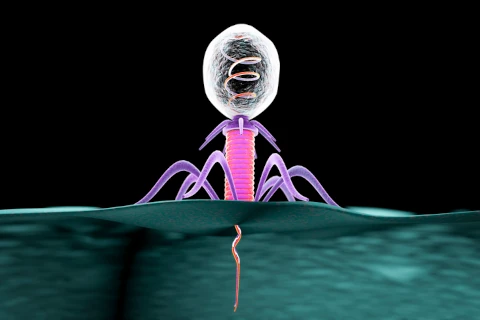What is a bacteriophage?
- The CAMBRIDGE dictionnary gives this definition: Bacteriophage: masculine noun, a virus that grows and divides inside a bacterium, destroying it.Bacteriophages, also called phages, are viruses that infect bacteria. They are considered the natural predators of bacteria and play an important role in regulating their population.
The bacteriophage has a relatively simple structure, consisting of a DNA or RNA genome encapsulated in a protein called a capsid. Some bacteriophages also have a protein envelope that protects them as they pass through the bacterial cell wall.
Bacteriophages have a close relationship with their bacterial host, as they need to reproduce inside it. When a bacteriophage infects a bacterium, it attaches to its surface and injects its genetic material into the bacterial cell. Once inside, the viral genetic material uses the resources of the bacterium to reproduce, producing hundreds of copies of the bacteriophage. They then destroy the bacterial cell, releasing the bacteriophages to infect other cells.
A bacteriophage is a virus that infects bacteria. They have a relatively simple structure and are very specific in their choice of host bacteria. Bacteriophages are the natural predators of bacteria, and play an important role in regulating the bacterial population. Discovered over a century ago, their use as therapeutic agents is making a strong comeback.

The lytic cycle and the lysogenic cyclee
The lytic cycle begins with the anchoring of the phage on the surface of the host bacterium. This step is followed by the penetration of genetic material into the cell. Once inside, the phage’s genetic material uses the bacterial cell’s composition to replicate rapidly. The new phages assembled in the host cell multiply in large quantities. This causes the cell membrane to burst. The bacterium is thus destroyed. The destruction of the bacterium is called “bacterial lysis”. Once the bacterium is destroyed and opened, it causes the release of new “phage” viruses that will infect other bacteria.
The lysogenic cycle involves the integration of the viral genetic material into the bacterial genome, creating a prophage. The latter is transmitted to daughter cells without causing lysis (destruction of the bacterium). However, in the event of environmental stress, the prophage can be excised and initiate the lytic cycle, leading to the release of new viruses.
The choice between the two modes of replication depends on factors such as the type of phage, the type of host bacterium, environmental conditions, and genetic events that can induce the switch from one mode to another.
Bacteriophage reproduction
The reproduction of bacteriophages is a crucial process for their survival and propagation. Each of the steps in this process is important to ensure the success of viral replication.
Step 1 Adsorption
The first step is adsorption. During this step, the bacteriophage binds to the surface of the host bacterium by recognizing specific receptors. Each type of phage has a different affinity for the surface receptors of bacteria. This determines the host specificity for the phage. This is how it recognizes which bacterium it is connected to. This process is very important for the reproduction of bacteriophages as it allows the virus to specifically attach to the host bacterium.
Step 2 Reproduction
The second step of bacteriophage reproduction is penetration. Once the bacteriophage has attached to the surface of the host bacterium, it must penetrate inside it in order to reproduce. To do this, it plants its tail that goes through the wall and the cell membrane. This allows it to inject its genetic material (DNA or RNA) inside the host bacterium. Some phages can also enter the bacterium by being ingested. This step is crucial as it allows the phage’s genetic material to penetrate the host bacterium, where it can replicate.
Step 3 Replication
The third step in the bacteriophage reproduction process is replication. When the phage’s genetic material is inside the bacterium, it takes control of the cellular machinery to replicate itself. The bacterium is then under control. The phage uses the resources of the bacterium to synthesize its own proteins and DNA. This is how the bacterium, under control, is now forced to manufacture all the parts of the new phages. This step can take several hours and occur exponentially. Replication is a key step for the production of new phages and is crucial for the propagation of the virus.
Step 4 Assembly
In the process of bacteriophage reproduction, the fourth step is assembly. After the bacteriophages have copied their DNA inside the bacterium, they use these new phage components to assemble them. This is how they build new phages. The proteins of the phage head gather around the copied DNA to create the structure of the mature phage. The phage also synthesizes the tails, fibers, and other parts that allow it to attach to other bacteria at this stage. When assembly is complete, the phage is ready to release the new viruses.
Step 5 Release
The final step in the process of bacteriophage reproduction is release. At this stage, the host bacterium is destroyed to release the new phages. The phages replicate in large numbers inside the bacterium, causing its lysis, or destruction of its cell wall and plasma membrane. The new phages are then released into the environment. They can therefore infect new bacteria and repeat the reproduction cycle. Some phages can also release from the host cell without destroying it, using budding. This step is essential for the survival and propagation of bacteriophages.
By destroying bacteria, bacteriophages can be used therapeutically to treat multi-resistant bacteria : “cystitis, osteitis, lung infections, etc.“.
This therapy is called phage therapy. To understand its therapeutic function, click on the following link: “How does phage therapy work”
To discover the functioning of a bacteriophage in video, click on the following link: The deadliest being on planet Earth: the bacteriophage.


